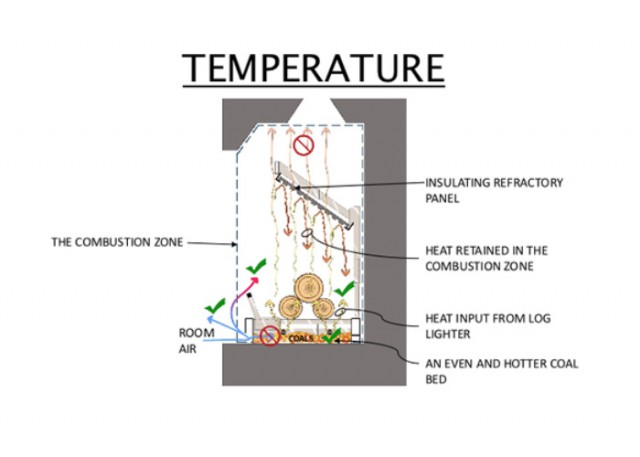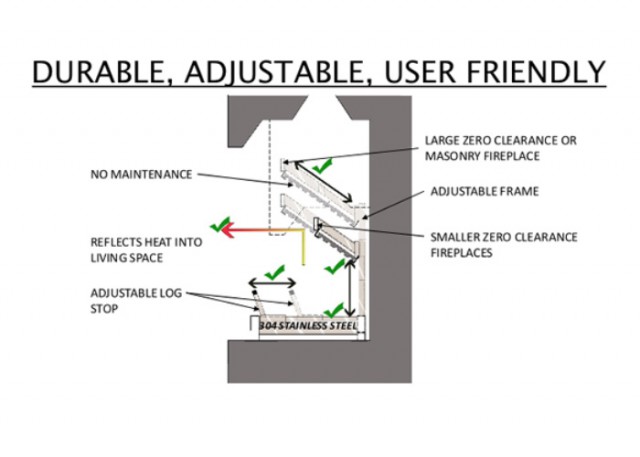Accomplishing Good Combustion Through Good Design.
Unlike other products that focus on removing the pollutants from a poorly burning fire, Earth’s Flame addresses the source of the fireplace emission – the poorly burning fire. Earth’s Flame reduces emissions by promoting good combustion in the fireplace. The Earth’s Flame design primarily accomplishes good combustion by improving the time honored 3 T’s of good combustion – Time, Temperature, and Turbulence. Other combustion friendly and pollution reducing features are also incorporated in the design. Here’s how we did it:
1. The Fire Needs to Burn Longer
 Incomplete combustion is a problem in fireplaces that largely contributes to fireplace emission levels. The longer the time combustion gases spend in the higher temperatures of the combustion zone the more completely they will combust and subsequently the lower the emissions will be from the fire. Earth’s Flame has a refractory panel above the fire that makes the flames travel a longer distance before exiting the combustion chamber. This longer path increase the residence time of the gases thus promoting a better overall burn and a reduction in emissions.
Incomplete combustion is a problem in fireplaces that largely contributes to fireplace emission levels. The longer the time combustion gases spend in the higher temperatures of the combustion zone the more completely they will combust and subsequently the lower the emissions will be from the fire. Earth’s Flame has a refractory panel above the fire that makes the flames travel a longer distance before exiting the combustion chamber. This longer path increase the residence time of the gases thus promoting a better overall burn and a reduction in emissions.
2. The Temperature of the Fire Needs to be Higher
 The higher the temperature in the combustion zone the better the overall burn and the lower the emission. Earth’s Flame has three features that promote a higher temperature in this zone:
The higher the temperature in the combustion zone the better the overall burn and the lower the emission. Earth’s Flame has three features that promote a higher temperature in this zone:
- Earth’s Flame is a hybrid device which uses a modified Blue Flame gas fired log lighter in the design, a device well known to the industry for over 55 years. Earth’s Flame uses the log lighter and a small amount of gas not only to quickly ignite the initial fire but sustain the continued burning and re-ignition events such as re-stoking the fire. Temperature in the combustion zone is increased and evenly maintained. Temperatures do not fluctuate as radically as they do in a traditional fire. The log lighter used in Earth’s Flame has been redesigned from the traditional Blue Flame log lighter to more evenly distribute the heat and ignition source under the wood. This creates a much more even burn of the wood. A higher temperature combined with an even and sustained burn of the wood helps eliminate those large emissions events found in traditional fireplaces.
- Using a traditional grate, the air entering the fireplace hits the coals under the wood. This air has a tendency to eliminate the coals under the front of the grate. The result is an uneven coal bed under the wood, promoting combustion in the rear of the firebox but not in the front of the firebox. Earth’s Flame has a tube running the width of the firebox that deflects this air away from the coal bed resulting in a more even bed of coals under the wood from the front to the rear of the grate. This increases the temperature below the wood and promotes a more even burn of the wood.
- An insulating refractory panel placed at an angle above the burning wood helps retain heat in the combustion zone. This again increases the burn temperature and promotes better combustion of the wood.
3. Create Better Turbulence in the Combustion Gases
 A traditional fireplace has very little turbulence in the combustion gases once they leave the burning wood, the flame path is straight up the chimney. There are oxygen starved parts of these gases that have not completely combusted. The temperature of the flame path is also not uniform, very hot in spots and cooler in others. The more turbulence that is encountered in the combustion gas path the better these gases mix with the surrounding oxygen, the more uniform the gas temperature, and the more complete the burn. Earth’s Flame grooved refractory panel above the wood burning zone and the circuitous flame path promotes the necessary turbulence and mixing required for good combustion.
A traditional fireplace has very little turbulence in the combustion gases once they leave the burning wood, the flame path is straight up the chimney. There are oxygen starved parts of these gases that have not completely combusted. The temperature of the flame path is also not uniform, very hot in spots and cooler in others. The more turbulence that is encountered in the combustion gas path the better these gases mix with the surrounding oxygen, the more uniform the gas temperature, and the more complete the burn. Earth’s Flame grooved refractory panel above the wood burning zone and the circuitous flame path promotes the necessary turbulence and mixing required for good combustion.
4. Generate a 2nd Combustion Zone
 The tubular design allows oxygen rich room air to be induced into the hollow tubes of the grate. The air is preheated as it travels through the tubes under the wood fire, as it rises through vertical tubes, and ultimately exits through holes placed around the refractory panel. The exit point of this air is in direct contact with the split flame path of the combustion gases in an area where turbulence and mixing has been created. When oxygen deficient combustion gases enter this area they find an environment friendly to complete their combustion. Earth’s Flame design in essence creates a secondary combustion zone within a traditional fireplace.
The tubular design allows oxygen rich room air to be induced into the hollow tubes of the grate. The air is preheated as it travels through the tubes under the wood fire, as it rises through vertical tubes, and ultimately exits through holes placed around the refractory panel. The exit point of this air is in direct contact with the split flame path of the combustion gases in an area where turbulence and mixing has been created. When oxygen deficient combustion gases enter this area they find an environment friendly to complete their combustion. Earth’s Flame design in essence creates a secondary combustion zone within a traditional fireplace.
5. Re-Burn Particles That Otherwise Would be an Emission
 Particulate normally entrained in the combustion gases with mechanically impinge on the refractory panel above the fire and fall out of the gas stream. This occurs while the flame path is making an abrupt turn from its intended path. The particle will drop back into the primary combustion zone and be re-entrained for additional burn time. A particle that would have been an emission in a traditional fireplace is more completely combusted by the Earth’s Flame design.
Particulate normally entrained in the combustion gases with mechanically impinge on the refractory panel above the fire and fall out of the gas stream. This occurs while the flame path is making an abrupt turn from its intended path. The particle will drop back into the primary combustion zone and be re-entrained for additional burn time. A particle that would have been an emission in a traditional fireplace is more completely combusted by the Earth’s Flame design.
Besides it’s Durability, Being Adjustable, and User-Friendly, here are other features:
- Earth’s Flames refractory panel is adjustable in both depth and height to accommodate most any fireplace geometry.
- Earth’s Flame is easy to install, easy to use, and requires no maintenance.
- Durably constructed of high temperature and corrosion resistant 304 Stainless Steel Earth’s Flame will reduce emissions with the same efficiency over its entire lifespan.
- Although not tested at this time, we believe the angled refractory panel above the fire will also reflect more heat back into the living space making the fireplace more thermally efficient.









